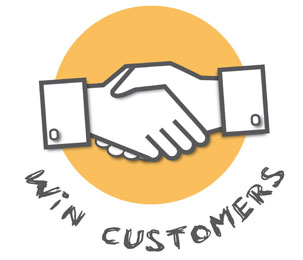Ten years ago, the phrase “content marketing” was not commonplace. But today is very different, and every business needs to understand how to implement content marketing strategies.
The Content Marketing Institute defines content marketing as “a strategic marketing approach focused on creating and distributing valuable, relevant, and consistent content to attract and retain a clearly-defined audience — and, ultimately, to drive profitable customer action.”
Joe Pulizzi, founder of the Content Marketing Institute, traces the origins of content marketing to a cave painting from 4200 B.C. He describes the painting as translating to “Six ways a spear can save your life from a wild boar.”
If you hunted wild boar, you’d probably want to know more and might even be inclined to get your next spear from the person who made the painting, or maybe the person who told you about the painting was someone who had previously sold you hunting equipment. Either way, the content helped reinforce the message.
There are three keys to creating a successful content marketing strategy today. Many companies struggle to get started and then struggle to sustain momentum over time.
The trick is in understanding the long-term value of content marketing and that buying patterns have changed and are continuing to change with the increasing use of the Internet and (especially) smartphones. Your brand needs to offer more than just a product.
1. Aligning marketing and sales. The goal of marketing is sales. Marketing is not tasked with closing a sale but to create brand awareness and lead generation. In the B2B space, content marketing is essential to providing value-based information at the right time in the buying cycle.
For the process to work, marketing needs to know the goals of the sales organization and the target audience for each product and market segment. Without understanding these elements, marketing is working in the dark.
“The hardest part of any content marketing strategy is getting started,” says Austin LaRoche, CMO and partner at ATAK Interactive. “Most business owners and managers struggle to connect the right content strategy with their sales targets.”
This is where having a clear understanding of your audience is essential. The first question when working with a B2B company should always focus on sales goals. “That way we know what we’re trying to accomplish before we develop a marketing plan,” says LaRoche.
Once the goals are established, a plan for achieving them can be developed.
Knowing the goals also helps develop metrics by which the plan can be measured. Recognize upfront that not every element of a plan will work as desired. Still it’s important to stick with a plan because marketing success doesn’t happen overnight: persistent, consistent messaging is essential, especially nowadays, when customers and prospects are being inundated with marketing messages in print, on TV, by email, and on mobile devices.
Unfortunately there is not a “one size fits all” approach to content marketing. The good news is that just a few key elements are necessary to be successful and help drive sales. Still the way we communicate has changed, and marketing and sales need to follow suit.
2. Use a marketing calendar. First it’s important to produce content on a consistent basis. Building trust within your target audience takes time, and content marketing isn’t magic: a single video or blog post will not change your business.
When getting started, decide how often you’re going to produce content, what type of content you’re going to create, and how the content will be delivered. “Once decided, stick with the plan,” says LaRoche.
For example, my team at Nova Polymers uses a combination of Basecamp.com and Google Drive to manage our content and marketing initiatives. There are other tools that can be used, but the important part is the strategy behind what we’re doing. Content and how it’s scheduled should all tie into your overall marketing strategy, and everything should lead back to your sales goals.
3. Make your Web site a responsive hub. Think of your Web site as the hub of your business. Google processes over 3.5 billion searches per day. Your customers are part of this group as they seek out content and companies to do business with.
If you want your Web site to generate leads and provide real value, it needs to be the central location where customers and prospects can go to consume your content and connect with you—and not be just a digital brochure.
To address this need, your Web site needs to be regularly updated with photos, written content, and even video. Everything you add should make things easy for visitors and help deliver value.
And as you do all this, search engines take notice. They look favorably at steady Web site activity, seeing updates as a sign of relevant and current information. This helps with SEO (search engine optimization), rankings, and helps prospects find your site by putting your business among the top rankings.
The bad news is that if your present site hasn’t been updated recently it probably isn’t working for you. Many older sites do not use a CMS (Content Management System) that makes information easy to find and are not mobile friendly. That is, they do not display well on smartphones and tablets. Updates are time-consuming, difficult, and expensive, which is why they are often put on the back burner.
Happily newer platforms such as WordPress solve many of these problems. In fact, the W3Tech (World Wide Web Technical Survey) determined that 25 percent of all Web sites are on the WordPress platform. Why WordPress? Because it is an open source platform with a robust CMS that is easy to use and uses design templates that work well on different devices.
Open source means there are hundreds of plug-ins that can be added to your site to provide different functionality. For example, modern Web sites geared for content marketing have contact forms throughout the site to make capturing visitors’ information easy. Every page can be shared on social media, all content is SEO optimized, and there are lots of great (and often free) images to help tell your story more easily and in a compelling way.
Every email or direct mail campaign you create should drive the customer or prospect to a customized page on your site called a landing page. The landing page should be clear, provide a promised piece of content (such as a white paper), and have a clear Call To Action (CTA).
The CTA is an action you want the prospect to do to qualify them as a lead. Be sure to capture an email address and preferably a phone number for easy follow up. And make it clear that you do not share or sell site visitor information with any third parties.
It’s the twenty-first century version of that cave painting—and instead of a cave wall, it starts on your Web site.
By Mike Santos
All photos: Shutterstock.com











